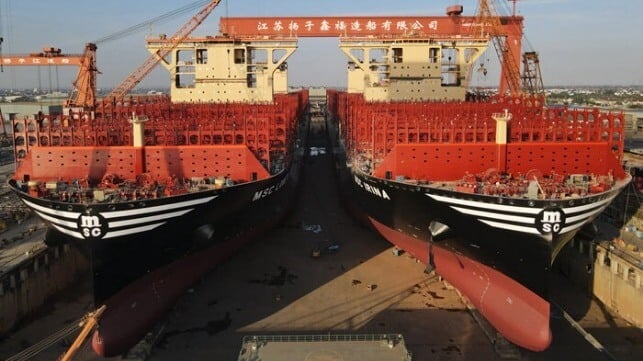BIMCO: Containership Orderbook Reaches New High Fueling Growth to 2029

The container shipping segment started its latest wave of rapid growth in the past few years as carriers moved to order larger vessels to meet capacity demands. The industry trade group BIMCO reports in its year-end analysis of the segment that the orderbook continues to grow for containerships even with the ongoing deliveries from the orders that started in 2021.
“At the end of 2024, the containership order book was 8.3 million TEU, a new record compared with the previous high of 7.8 million TEU in early 2023,” says Niels Rasmussen, Chief Shipping Analyst at BIMCO. By comparison in April 2022, BIMCO calculated that the containership orderbook had surpassed 6.5 million TEU, marking the first time it has reached that level in 15 years. Rasmussen at the time noted that 6 million TEU had been added in just 18 months.
Despite deliveries hitting a record high of 2.9 million TEU in 2024, BIMCO reports an additional 4.4 million TEU was ordered in 2024. It was the second highest-ever level of capacity ordered in a year.
The sector stands at just under 7,200 active containerships according to Alphaliner’s end-of-year calculations. It shows a total capacity of just under 31.5 million TEU.
The new vessels will continue to enter the market in 2025 with 99 percent of the current orders due for delivery by 2029. However, BIMCO highlights five ships have already been ordered for delivery in 2030. BIMCO reports an average of 1.9 million TEU will be delivered between 2025 and 2028 with the peak year in 2027 with 2.2 million TEU of capacity scheduled for delivery. A further 0.7 million TEU of capacity will be delivered in 2029.
The industry’s order focus continues to be on larger vessels. Rasmussen reports that 92 percent of the orderbook capacity is for ships of 8,000 TEU or larger. The largest segment, 12,000 to 17,000 TEU makes up 46 percent of the order capacity.
Speculation is that some of the tonnage is fleet replacement, such as Maersk which reported it would maintain its overall size using the ships to modernize the fleet and meet pending emissions regulations. Despite that, the expectation is that recycling will continue to lag behind the deliveries.
Over the past four years, BIMCO highlights only 166 containerships with 256,000 TEU of capacity were recycled. As a result, the average age of vessels continues to increase. It has increased 1.4 years since 2020 with the numbers of ships 20 years or older making up 11 percent of the fleet or 3.4 million TEU of capacity. Rasmussen notes the record for recycling was 657,000 TEU.
“It would require 680,000 TEU per year to recycle all ships 20 years old or older during the next five years, but actual recycling is likely to end lower,” predicts Rasmussen. “As long as ships cannot fully return to the Red Sea, recycling will likely continue to be low and at the same time, the smaller ship segments tend to be recycled later than average. Therefore, average annual fleet growth during the next five years could end higher than 3 percent.”
BIMCO notes if all ships 20 years old or older are recycled during the next five years, the fleet would grow to 35.8 million TEU by the end of 2029, assuming no more ships are contracted for delivery before 2030. That is equal to 16 percent growth or average annual growth of 3 percent. The segments smaller than 8,000 TEU would see an average annual contraction of 4 percent while the segments 8,000 TEU or larger would grow on average 7 percent per year.
The growth through new construction and acquisitions is being driven by many of the largest companies. MSC Mediterranean Shipping Company for example has grown to over 6.3 million TEU with Alphaliner reporting it has a further 2.1 million TEU on order. Maersk remains stable at 4.4 million TEU while CMA CGM, currently third largest at 3.8 million TEU has the sector’s second-largest orderbook. Alphaliner reports CMA CGM’s orders at 1.15 million TEU.
